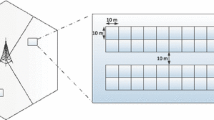Abstract
Analytical methods on grade of service (GoS, quantified by the blocking probability which is denoted as \(P_b\)) evaluation in orthogonal frequency division multiple access cellular networks for real-time traffic are important for cell-dimensioning. Existing works use simplified spectral efficiency (SE) models that lead to conservative outcomes. For computing cell-wide and cell-average \(P_b\) the exact but mathematically intractable Kaufman Roberts algorithm (KRA) is indispensable. The Erlang approximation (EA) tractably computes only cell-average \(P_b\) but ignores bandwidth allocation granularity leading to an error of around 25 % in typical scenarios. In this work, by using an accurate SE model we show a significant reduction in projected base station (BS) density requirement for maintaining satisfactory cell-average \(P_b\). We show that cell-average \(P_b\) does not completely depict the GoS situation within a cell since there is significant variation of \(P_b\) inside it. Further, we enhance the EA in two ways. Firstly, we improve its accuracy to within 2 % of KRA by accounting for bandwidth allocation granularity. Secondly, we extend it to compute cell-wide \(P_b\) like the KRA. The resulting method helps to explain properties such as the linearly increasing trend of region-wise \(P_b\) versus region-index in case of low bit-rate streaming calls. We also use the aforementioned linearly increasing trend to arrive at another alternative to KRA. The development of these two alternatives to KRA highlights certain interesting properties of region-wise and cell-average \(P_b\) as well as the EA. The error in estimated BS density requirement with these alternatives in case of 12.2 kbps voice in the interference limited situation is negligibly small. We employ discrete event simulations to validate our models.





















Similar content being viewed by others
Notes
In case of packet switched real-time traffic the packet arrival rate and the packet size also characterize the call.
This algorithm will be described in Sect. 3.
If \(\overline{N^{req}_{sc}}\) is integer valued then \(|\Omega _i| = \overline{N^{req}_{sc}} \quad \forall \, i \in \{0,1,\ldots ,N_{srv}\}\).
Using (9) and (17) we have \(P_b(1) = q(N_{sc})\) and \(P_b(M) = \sum ^{N_{sc}}_{n=N_{sc} - M + 1} q(n)\) which implies that only the values of \(q(n)\) for \(n\) varying between \(N_{sc}-(M-1)\) and \(N_{sc}\) (the last \(M\) values of \(q(n)\)) are relevant for \(P_b\) computation. We call this the useful ‘tail’ portion of \(q(n)\) since it involves the last few values of \(q(n)\) that are the only ones actually used.
The fourth term is given by \(0.045\psi (\beta ,N_{srv}-3)\) and the fifth term by \(0.002\psi (\beta ,N_{srv}-4)\), both terms being evidently small compared to the first three which are \(0.2\psi (\beta ,N_{srv})\), \(0.593\psi (\beta ,N_{srv}-1)\) and \(0.234\psi (\beta ,N_{srv}-2)\) respectively.
References
Mouly, M., & Pautet, M.-B. (1992). The GSM system for mobile communications. C & Sys.
Sesia, S., Toufik, I., & Baker, M. (2009). LTE—the UMTS long term evolution: From theory to practice. New York: Wiley.
“Mobile WiMAX Parts I and II,” WiMax Forum, Technical Report, June 2006. [Online]. http://www.wimaxforum.org
“Cisco Visual Networking Index: Forecast and Methodology, 2012–2017,” Cisco, Technical Report, [Online]. http://www.cisco.com
Das, S. S., et al. (2012). Estimation of effective radio resource usage for VoIP scheduling in OFDMA cellular networks. In IEEE 75th vehicular technology conference, Spring.
Rappaport, T. S. (1996). Wireless communications principles and practice. Englewood Cliffs: Prentice Hall Inc.
Batabyal, S. & Das, S. S. (2012). Distance dependent call blocking probability, and area erlang efficiency of cellular networks. In IEEE 75th vehicular technology conference, Spring.
Shannon, C. E. (1948). A mathematical theory of communication. The Bell System Technical Journal, Tech. Rep., [Online]. http://cm.bell-labs.com/cm/ms/what/shannonday/shannon1948
Karray, M. K. (2010). Analytical evaluation of QoS in the downlink of OFDMA wireless cellular networks serving streaming and elastic traffic. IEEE Transactions on Wireless Communications, 9(5), 1799–1807.
Mogensen, P., et al. (2007). LTE capacity compared to the Shannon bound. In IEEE 65th VTC-Spring (pp. 1234–1238).
Karray, M. K. (2010). Evaluation of the blocking probability and the throughput in the uplink of wireless cellular networks. In Proceedings of international conference on communications and networking (ComNet) (pp. 4–7).
Joshi, G., et al. (2011). Downlink Erlang capacity of cellular OFDMA. In Proceedings of NCC.
Zhang, B., Iyer R., & Kiasaleh K. (2006). Reverse link Erlang capacity of OFDMA wireless systems with adaptive resource allocation. In IEEE wireless communications and networking conference (vol. 4, pp. 2106–2109).
Kaufman, J. S. (1981). Blocking in a shared resource environment. IEEE Transactions on Communications, 29(10), 1474–1481.
Roberts, J. (1981). A service system with heterogeneous user requirements. In Proceedings of the international conference on performance of data communications systems and their applications (pp. 423–431).
Błaszczyszyn, B., & Karray, M. K. (2009). Dimensioning of the downlink in OFDMA cellular networks via an Erlang’s loss model. In Proceedings of European wireless conference.
Bertsekas, D., & Gallager, R. (1987). Data networks. Englewood Cliffs: Prentice-Hall Inc.
Asadi, A., et al. (2013). A survey on opportunistic scheduling in wireless communications. IEEE Communications Surveys Tutorials, 15(4), 1671–1688.
Chung, S.-P., & Chen, Y.-W. (2012). Performance analysis of call admission control in SFR-based LTE systems. IEEE Communications Letters, 16(7), 1014–1017.
Holma, H., & Toskala, A. (2009). LTE for UMTS—OFDMA and SC-FDMA based radio access. New York: Wiley.
Guerin, R. A., et al. (1991). Equivalent capacity and its application to bandwidth allocation in high-speed networks. IEEE Journal on Selected Areas in Communications, 9(7), 968–981.
Kelly, F. P. (1991). Effective bandwidths at multi-class queues. Queuing Systems, 9, 5–15.
ITU-R, Guidelines for evaluation of radio interface technologies for IMT-Advanced. ITU-R, Tech. Rep. M.2135-1, 2009. [Online]. http://www.itu.int
Author information
Authors and Affiliations
Corresponding author
Rights and permissions
About this article
Cite this article
Batabyal, S., Das, S.S. GoS Evaluation for OFDMA Cellular Networks. Wireless Pers Commun 83, 925–957 (2015). https://doi.org/10.1007/s11277-015-2433-z
Published:
Issue Date:
DOI: https://doi.org/10.1007/s11277-015-2433-z




